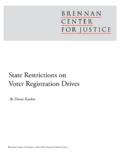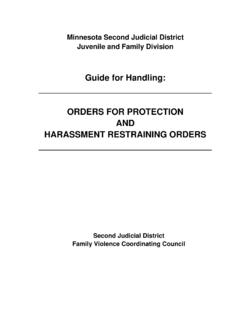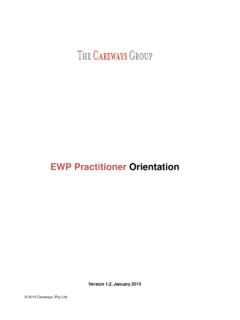Transcription of Countering Violent Extremism: Myths and Fact
1 For more information, contact Faiza Patel at or Michael German at Countering Violent extremism : Myths and Fact Over the last two years, the Obama administration and Congress have promoted Countering Violent extremism or CVE as a soft counterterrorism methodology designed to empower communities and build resilience to extremism . But CVE isn t a new concept, and the flawed foundation on which these programs are built all but ensures that they have negative impacts, including: stigmatizing Muslims and reinforcing Islamophobic stereotypes, facilitating covert intelligence-gathering, suppressing dissent against government policies, and sowing discord in targeted communities. As more CVE programs are implemented, the more important it is shed light on the Myths on which they are based: Myth #1: CVE Programs Prevent Terrorism The assumption behind CVE programs is that there is a predictable process by which individuals become terrorists, and that there are visible signs that law enforcement, families, and teachers can identify.
2 This model rests on false premises. All serious empirical studies including those funded by the government have concluded there is no typical trajectory that a person follows to become a terrorist. The FBI and NYPD identified common Muslim religious behavior as a predictive indicator of terrorist tendencies, theories that were thoroughly debunked. More recent government-sponsored materials point to signs of social marginalization, alienation, psychological disorders, and political grievances as warning signs. But decades of empirical study show that terrorists don t typically display signs of mental illness. The other signs of pre-terrorism that the government points to are patently overbroad and have no basis in science either.
3 Myth #2: We Have to Do Something Some CVE supporters argue that the lack of evidence supporting these presumptions results from a lack of study, and the imperative to do something in the face of a growing extremism problem requires action rather than analysis. But we shouldn t take actions that will be counterproductive. Studies of CVE programs in the United Kingdom, Europe, Kenya, Indonesia, and Australia demonstrate that these efforts are often harmful and counterproductive. In 2010, the House of Commons called a British CVE program s exclusive focus on Muslims , stigmatizing, [and] potentially alienating. A 2014 report produced for the European Parliament concluded that [e]mpirical studies show that broadening the scope of soft counter-radicalisation measures to what is considered traditionally community cohesion work.
4 Is detrimental to both objectives of Countering radicalization and fostering community cohesion. A comprehensive 2011 literature review produced for the Australian government declared that the dominant theme in CVE research was that strategies for Countering Violent extremism can erode democratic principles and social cohesion, increase radicalization and incite conflict and violence. Myth #3: CVE Programs Don t Target Muslims Descriptions of CVE programs don t necessarily identify the particular community being targeted. Indeed, proponents of these programs sometimes point to the increase in right wing domestic terrorism as a necessary target for CVE. In reality, as is clear from the White House CVE strategy and planning documents and the February 2015 White House CVE summit, Muslim communities are currently the principal if not sole target of CVE programs.
5 The three pilot CVE programs in Boston, Los Angeles and Minneapolis are conducting outreach to Muslim communities and are not making any effort to address other types of domestic terrorism. This focus paints American Muslims as inherently suspect and alien from American society, feeding into the anti-Islam narrative that is becoming increasing dominant in our public discourse. In fact, as law enforcement agencies have acknowledged time and again, American Muslims have an exemplary record of cooperation in counterterrorism efforts. According to studies by the Triangle Center on Terrorism and Homeland Security and the Muslim Public Affairs Council, the American Muslim community is law enforcement s single largest source of information used to foil terrorism plots since 9/11.
6 Of course, if history is any guide, programs developed for Muslims will be used against other groups as well. Law enforcement reports have identified groups opposed to gun control, immigration, abortion, taxes, and even third party candidates as far right extremists, who might become Violent . Environmental activists, Occupy protesters and the Black Lives Matter movement have all become targets for intelligence-gathering as well. Myth #4: CVE is an Alternative to Harsh Law Enforcement A ction In the United States, freedom of information requests and lawsuits have shown that CVE community outreach programs were either designed as, or devolved into, surreptitious intelligence-gathering tools, undermining the mutual trust these initiatives depend on for success.
7 The new generation of programs doesn t contain safeguards to ensure they won t be used for intelligence-gathering and prosecution. One troubling new element of CVE programing is the announced intention to involve public schools in identifying at risk youth. For example, a representative of the Minneapolis Public Schools appeared at an event with the Minnesota Attorney to announce that Minnesota schools were starting a CVE program to monitor Somali-American children in the lunchroom, non-class environments, and after school. She said the purpose would be to help spot identity issues and disaffection. The initiative is based on flawed premises: that these issues lead inexorably to terrorism and that lunch room monitors will be able to spot behaviors indicative of alienation.
8 Not surprisingly, this tactic has raised serious concerns within the city s Somali-American communities, as expressed in a public letter to federal and local law enforcement. CVE framework documents from the Attorney s Office in Boston similarly envision school-based CVE programming, to enhance awareness within K-12 and higher education regarding behavior assessment and care protocols and how peers can connect individuals to assessment and care teams. The theory that there are detectable behaviors that predict terrorist violence has been so thoroughly disproven that even the Boston CVE framework states, Researchers across the globe have made it clear that the path to Violent extremism is not linear and there are no valid or reliable indicators to predict who is more likely to engage in Violent extremism .
9 Finally, the National Counterterrorism Center s 2014 CVE guide includes a four-page list of risk and protective factors that police officers, public health workers, educators, and social service departments could use to assess individuals, families, and communities. These included measuring (on a five-point scale) qualities such as experiences of loss or trauma; expressions of hopelessness or futility; and connection to group identity (race, nationality, religion, ethnicity); and even the level of parent-child bonding. Needless to say, these qualities are all prevalent in many children who never become Violent , much less terrorists. Given the conceded lack of signs of pre-terrorism, how will children be identified for interventions?
10 And when will these children be reported to the FBI or the Attorneys who are running CVE programs? Myth #5: CVE Programs Are Community-Driven The language of community empowerment in which CVE programs are packaged is an attractive distractor. In fact, these programs have proven highly divisive among the communities at which they are targeted. In Boston, Minneapolis, and Los Angeles where the new generation of CVE programs are being piloted a range of grassroots Muslim groups have expressed serious reservations about these initiatives. Many CVE initiatives promise social services to target communities. While afterschool activities, youth mentorship programs and the like are worthwhile endeavors in their own right, and are sorely needed in many under-resourced neighborhoods, the counterterrorism umbrella is not the right framework for implementing them.
















